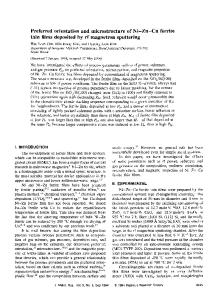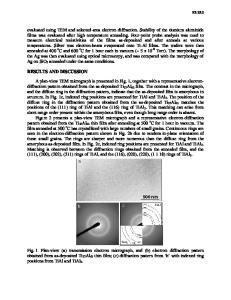The Origin of Stress in Co-Cr Alloy Thin Films Deposited by Magnetron Sputtering
- PDF / 341,420 Bytes
- 6 Pages / 420.48 x 639 pts Page_size
- 19 Downloads / 315 Views
THE ORIGIN OF STRESS IN Co-Cr ALLOY THIN FILMS DEPOSITED BY MAGNETRON SPUTTERING Zhi-feng ZHOU* AND Yu-dian FAN** *Foshan Ceramics Research Institute, Foshan City, Guangdong 528031, CHINA. **Department of Materials Science and Engineering, Tsinghua University, Beijing 100084, CHINA.
ABSTRACT Co-Cr alloy thin films are considered as an applicable perpendicular magnetic recording medium, and their mechanical properties such as internal stress can not be neglected. In this experiment, Co-Cr films are deposited on glass substrates by D. C. planar magnetron sputtering, and the effects of film thickness, Ni-Fe underlayer as well as substrate temperature on the stress are studied respectively. The stresses are all tensile in all cases, and the stress existing at the film-substrate interface is very small. According to the above experimental results and the structure analysis of the films, the atomic peening effect produced by the rebounded working gas atoms can be negligible, and the stress is thought to originate from the film growth process but not from the interfacial effect. Therefore, the structural defect elimination model is proposed (here the defects mainly include vacancies and grain boundaries). With this model, the origin of the tensile stress as well as the relations between the stress and the deposition conditions are explained qualitatively.
INTRODUCTION As Co-Cr alloy thin films possess superior magnetic properties for perpendicular magnetic recording, they show a wide application prospect[l]. However, few attention has been paid to their mechanical properties such as internal stress until now, and the origin of stress is not clear. It is important to study the relations between the stress and the deposition conditions for the control of the stress in the actual production process, and further understanding on the film growth mechanism will be made by the study of the stress origin model in theory. In this case, we investigated the stress in Co-Cr films deposited by D. C. planar magnetron sputtering under various deposition conditions, e.g., film thickness, working gas pressure, negative bias voltage, deposition rate, incidence angle and annealing temperature [2]. All the experimental results showed that the stresses were all tensile except for the film deposited at a bias voltage of -200V, but the origin of the tensile stress was not discussed in detail. Therefore, a further study is taken in this paper. EXPERIMENTAL PROCEDURE AND RESULTS The Co-Cr (20at% Cr) alloy thin films were deposited by D. C. planar magnetron sputtering on glass substrates with the thickness of 0.2mm, and the effect of film thickness, Ni-Fe underlayer and substrate temperature on the stress would be taken into account. All the experiments were performed under the background pressure of 2.7*10-4Pa, and the surface of substrates was cleaned by plasma bombardment before deposition. The film thickness was controlled by controlling the sputtering time. The working gas pressure of Ar was 0.40Pa, and the deposition rate was fixed to be 5
Data Loading...










